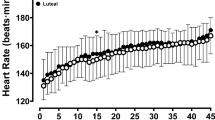Summary
Rectal (Tre) and mean skin temperatures, heart rate (fc) and sweat rate (Msw) during exercise in a hot, dry environment were compared among four menstrual women (both before and after ovulation), four amenorrheal women and four men, all with similar aerobic capacities. Progesterone and estrogen were compared in a pair of monozygotic twins (one menstrual and one amenorrheal) who participated in the study. Before acclimation, subjects were given a heat-stress test (HST) consisting of treadmill walking at 25%–30% \(\dot V_{O_2 }\) max in a hot, dry environment (Tdb/Twb=48/25‡ C) until Tre reached 39‡ C or fc reached 160 beat·min−1. Subjects were then acclimated to the dry heat with conventional acclimation procedures. After acclimation, subjects were given a HST which continued for 3 h. Before acclimation Tre and fc increased more rapidly in the women, which resulted in significantly shorter HST times for the women as compared with the men. Following acclimation all subjects maintained similar Tre, fc, and sweat rates. There were no differences between the exercise/heat-stress responses of the preovulatory menstrual women, postovulatory menstrual women, and amenorrheal women. Although the estrogen concentrations were normal in the menstrual twin, her progesterone concentrations were significantly depressed. Both hormones were depressed in the amenorrheal twin. Following acclimation thermoregulatory function in dry heat did not differ between the sexes when fitness level was similar. Neither were there any differences in thermoregulation between the pre- and postovulatory phases of the menstrual cycle or between the menstrual and amenorrheal women.
Similar content being viewed by others
References
Avellini BA, Kamon E, Krajewski JT (1980) Physiological responses of physically fit men and women to acclimation to humid heat. J Appl Physiol 49: 254–261
Bittel J, Henane R (1975) Comparison of thermal exchanges in men and women under neutral and hot conditions. J Physiol (Lond) 250: 475–489
Brengelmann GL, McKeag M, Rowell LB (1975) Use of dewpoint detection for quantitative measurement of sweating rate. J Appl Physiol 39: 498–500
Davies CTM (1979) Thermoregulation during exercise in relation to sex and age. Eur J Appl Physiol 42: 71–79
Dill DB, Yousef MK, Nelson JD (1973) Responses of men and women to two hour walks in desert heat. J Appl Physiol 35: 231–235
Dubois D, Dubois EF (1916) Clinical calorimetry X. A formula to estimate the approximate surface area if height and weight be known. Arch Intern Med 17: 863–871
Eichna LW, Park CR, Nelson N, Horvath SM, Palmes ED (1950) Thermal regulation during acclimatization in a hot, dry (desert type) environment. Am J Physiol 163: 585–597
Frye AJ, Kamon E (1981) Responses to dry heat of men and women with similar aerobic capacities. J Appl Physiol 50: 65–70
Garden JW, Wilson ID, Rasch JP (1966) Acclimatization of healthy young adult males to a hot-wet environment. J Appl Physiol 21: 665–669
Haslag MW, Hertzman AB (1965) Temperature regulation in young women. J Appl Physiol 20: 1283–1288
Kawahata A (1960) Sex differences in sweating. In: Yoshimura EH, Ogata K, Itoh S (eds) Essential problems in climatic physiology. Nakado Publ, Kyoto, pp 169–184
Lind AR, Bass DE (1963) Optimal exposure time for development of acclimatization to heat. Fed Proc 22: 704–708
Mashaly MM, Wentworth BC (1974) A profile of progesterone in turkey sera. Poult Sci 53: 2030–2035
Morimoto T, Slabochova Z, Namanand RK, Sargent II F (1967) Sex differences in physiological reactions to thermal stress. J Appl Physiol 22: 526–532
Senay LC, Jr (1973) Body fluids and temperature responses of heat-exposed women before and after ovulation with and without rehydration. J Physiol (Lond) 232: 209–219
Shapiro Y, Pandolf KB, Avellini BA, Pimental NA, Goldman RF (1980) Physiological responses of men and women to humid and dry heat. J Appl Physiol 49: 1–8
Speroff L, Vande Wiele RL (1971) Regulation of the human menstrual cycle. Am J Obstet Gynecol 109: 234–247
Weinman KP, Slabochova Z, Bernauer EM, Morimoto T, Sargent II F (1967) Reactions of men and women to repeated exposure to humid heat. J Appl Physiol 22: 533–538
Wells CL (1980) Responses of physically active and acclimatized men and women to exercise in a desert environment. Med Sci Sports Exercise 12: 9–13
Wells CL, Horvath SM (1973) Heat stress responses related to the menstrual cycle. J Appl Physiol 35: 1–5
Wells CL, Horvath SM (1974) Responses to exercise in a hot environment as related to the menstrual cycle. J Appl Physiol 36: 299–302
Wineland MJ, Wentworth BC (1975) Peripheral serum levels of 17-Β-estradiol in growing turkey hens. Poult Sci 54: 381–387
Wyndham CH, Morrison JF, Williams CG (1965) Heat reactions of male and female caucasians. J Appl Physiol 20: 357–364
Author information
Authors and Affiliations
Rights and permissions
About this article
Cite this article
Frye, A.J., Kamon, E. & Webb, M. Responses of menstrual women, amenorrheal women, and men to exercise in a hot, dry environment. Europ. J. Appl. Physiol. 48, 279–288 (1982). https://doi.org/10.1007/BF00422988
Accepted:
Issue Date:
DOI: https://doi.org/10.1007/BF00422988




